Geography of Laos
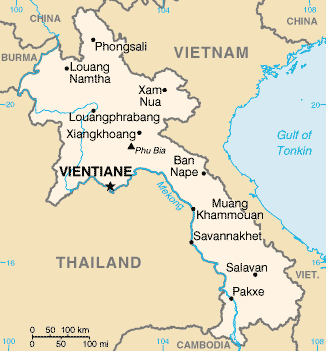
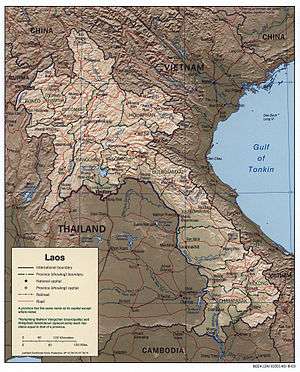
Laos is an independent republic, and a landlocked nation in Southeast Asia, northeast of Thailand, west of Vietnam. It covers 236,800 square kilometers in the center of the Southeast Asian peninsula and it is surrounded by Burma (Myanmar), Cambodia, the People's Republic of China, Thailand, and Vietnam. About seventy percent of its geographic area is made up of mountain ranges, highlands, plateaux, and rivers cut through.
Its location has often made it a buffer between more powerful neighboring states, as well as a crossroads for trade and communication. Migration and international conflict have contributed to the present ethnic composition of the country and to the geographic distribution of its ethnic groups.
Geographic coordinates: 18°00′N 105°00′E / 18.000°N 105.000°E
Topography
Most of the western border of Laos is demarcated by the Mekong River, which is an important artery for transportation. The Dong Falls at the southern end of the country prevent access to the sea, but cargo boats travel along the entire length of the Mekong in Laos during most of the year. Smaller power boats and pirogues provide an important means of transportation on many of the tributaries of the Mekong.
The Mekong has thus not been an obstacle but a facilitator for communication, and the similarities between Laos and northeast Thai society—same people, almost same language—reflect the close contact that has existed across the river for centuries. Also, many Laotians living in the Mekong Valley have relatives and friends in Thailand.
Prior to the twentieth century, Laotian kingdoms and principalities encompassed areas on both sides of the Mekong, and Thai control in the late nineteenth century extended to the left bank. Although the Mekong was established as a border by French colonial forces, travel from one side to the other has been significantly limited only since the establishment of the Lao People's Democratic Republic (LPDR, or Laos) in 1975.
The eastern border with Vietnam extends for 2,130 kilometres, mostly along the crest of the Annamite Chain, and serves as a physical barrier between the Chinese-influenced culture of Vietnam and the Indianized states of Laos and Thailand. These mountains are sparsely populated by tribal minorities who traditionally have not acknowledged the border with Vietnam any more than lowland Lao have been constrained by the 1,754-kilometre Mekong River border with Thailand. Thus, ethnic minority populations are found on both the Laotian and Vietnamese sides of the frontier. Because of their relative isolation, contact between these groups and lowland Lao has been mostly confined to trading.
Laos shares its short—only 541 kilometres—southern border with Cambodia, and ancient Khmer ruins at Wat Pho and other southern locations attest to the long history of contact between the Lao and the Khmer. In the north, the country is bounded by a mountainous 423-kilometre border with China and shares the 235-kilometre-long Mekong River border with Burma.
The topography of Laos is largely mountainous, with the Annamite Range in the northeast and east and the Luang Prabang Range in the northwest, among other ranges typically characterized by steep terrain. Elevations are typically above 500 metres with narrow river valleys and low agricultural potential. This mountainous landscape extends across most of the north of the country, except for the plain of Vientiane and the Plain of Jars in the Xiangkhoang Plateau.
The southern "panhandle" of the country contains large level areas in Savannakhét and Champasak provinces that are well suited for extensive paddy rice cultivation and livestock raising. Much of Khammouan Province and the eastern part of all the southern provinces are mountainous. Together, the alluvial plains and terraces of the Mekong and its tributaries cover only about 20% of the land area.
Only about 4% of the total land area is classified as arable. The forested land area has declined significantly since the 1970s as a result of commercial logging and expanded swidden, or slash-and-burn, farming.
List of mountains in Laos
- Phou Bia, 2,819 m
- Phu Xai Lai Leng, 2,720 m
- Rao Co, 2,286 m
- Phu Soi Dao, 2,120 m
- Phou Khe, 2,079 m
- Shiceng Dashan, 1,830 m
- Dong Ap Bia, 937 m
Climate

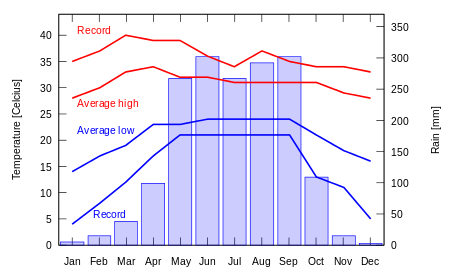
Laos has a tropical monsoon climate, with a pronounced rainy season from May through October, a cool dry season from November through February, and a hot dry season in March and April. Generally, monsoons occur at the same time across the country, although that time may vary significantly from one year to the next.
Rainfall varies regionally, with the highest amounts—3,700 millimeters (145.7 in) annually—recorded on the Bolovens Plateau in Champasak Province. City rainfall stations have recorded that Savannakhét averages 1,440 millimeters (56.7 in) of rain annually; Vientiane receives about 1,700 millimeters (66.9 in), and Louangphrabang (Luang Prabang) receives about 1,360 millimeters (53.5 in).
Rainfall is not always adequate for rice cultivation and the relatively high average precipitation conceals years where rainfall may be only half or less of the norm, causing significant declines in rice yields. Such droughts often are regional, leaving production in other parts of the country unaffected.
The average temperatures in January, coldest month, are, Luang Prabang 20.5 °C (minimum 0.8 °C), Vientiane 20.3 °C (minimum 3.9 °C), and Pakse 23.9 °C (minimum 8.2 °C); the average the average temperatures for April, usually the hottest month, are, Luang Prabang 28.1 °C (maximum 44.8 °C), Ventiane 39.4 °C). Temperature does vary according to the altitude, there is an average drop of 1.7 °C for every 1000 feet (or 300 meters). Temperatures in the upland plateux and in the mountains are considered lower than on the plains around Vientiane.
Agriculture
Agriculture in Laos is the most important sector of the economy. Five million out of 23,680,000 hectares of Laos's total land area is suitable for cultivation, and seventeen percent of the land area, between 850,000 and 900,000 hectares, is cultivated. Rice is the main crop grown during the rainy season both upland and wet. There is also a significant amount of fishing.
Agricultural cultivation is possible during with varying weather on a small portion of land area apart from the Vientiane plain and the lowlands along the Mekong Valley. These cultivated areas are situated in the valley cuts by the rivers or the plateau regions of Xieng Khouang in the North and in the Bolovens in the south. Typically there are only two ways to cultivate: either the wet-field paddy system practiced in the hills, or the swidden cultivation system practiced among the Lao Loum or lowland in Lao.
Population
Laos has a smaller population than most countries in South East Asia. The first comprehensive national population census of Laos was taken in 1985; it recorded a population of about 3.57 million. In 1987, the population was officially stated as 3,830,000 and the capital city, Vientiane, had a population of 120,000. The annual growth was estimated at between 2.6 and 3.0 percent. The national birth rate is estimated at about forty-five per 1,000, while the dead rate estimates at around sixteen per 1,000. The fertility rates are higher between ages twenty and forty which highlights the average woman giving birth to an average of 6.8 children.
The overall population density was only eighteen persons per square kilometer, and in many districts the density was fewer than ten persons per square kilometer Population density per cultivated hectare was considerably high ranging from 3.3 to 7.8 persons per hectare. The population is ethically diverse, but a complete classification of all ethnic groups has never been undertaken. Discrepancies in the number of groups resulted from inconsistent definitions of what constitutes an ethnic group as opposed to a subgroup, as well as incomplete knowledge about the groups themselves.
Transportation routes
Because of its mountainous topography and lack of development, Laos has few reliable transportation routes. This inaccessibility has historically limited the ability of any government to maintain a presence in areas distant from the national or provincial capitals and has limited interchange and communication among villages and ethnic groups.
The Mekong and Nam Ou are the only natural channels suitable for large-draft boat transportation, and from December through May low water limits the size of the draft that may be used over many routes. Laotians in lowland villages located on the banks of smaller rivers have traditionally traveled in pirogues for fishing, trading, and visiting up and down the river for limited distances.
Otherwise, travel is by ox-cart over level terrain or by foot. The steep mountains and lack of roads have caused upland ethnic groups to rely entirely on pack baskets and horse packing for transportation.
The road system is not extensive. A rudimentary network begun under French colonial rule and continued from the 1950s has provided an important means of increased inter-village communication, movement of market goods, and a focus for new settlements. In mid-1994, travel in most areas was difficult and expensive, and most Laotians traveled only limited distances, if at all. As a result of ongoing improvements in the road system started during the early 1990s, it is expected that in the future villagers will more easily be able to seek medical care, send children to schools at district centers, and work outside the village.
In October 2015 the first highway through the country was completed connecting southern China to Thailand.[1]
Inland waterways, including the Mekong River, is the second most important source of transport network. About 4,600 kilometers of navigable waterways are located within the Mekong, the Ou, and nine other rivers. The Mekong River is only navigable for about seventy percent of its length due to rapids and low water levels in the dry season.
Residents in the lower lands and villages of smaller river banks have traditionally traveled in pirogues for fishing, trading, or visiting up and down the river for limited distances. The public and private trade associations handle river traffic. There are a series of warehouses and ports in Savannakhet, Xeno, and Vientiane. The river transportation has improved since government policy expanded trade with Vietnam and other rural regions.
Natural resources
Expanding commercial exploitation of forests, plans for additional hydroelectric facilities, foreign demands for wild animals and nonwood forest products for food and traditional medicines, and a growing population have brought new and increasing attention to the forests. Traditionally, forests have been important sources of wild foods, herbal medicines, and timber for house construction.
Soils are found commonly throughout the floodplains. Typically, soils are formed from alluvium deposited by the rivers as either sandy clay in light colors or sand clay with gray or yellow colors. Upland soils derive from granitic, schistose, or sandstone parent rocks more acidic and less fertile. Southern Laos has areas of laterite soils, and basaltic soils in the Bolovens Plateau.
Plant Life and Animals
The north of Laos has tropical rain forests with broader leaved evergreens and monsoon forests of mixed evergreen and in the south is filled with deciduous trees. In the monsoon forest the ground is covered with tall, coarse grass. The trees mostly only reach their secondary growth. Typically there is an abundance of bamboo, scrub, and wild banana. Laos is also home to hundreds of species of orchids and palms.
Forests and fields serve as support for wildlife. Wildlife in Laos includes nearly 200 species of mammals, about the same number for reptiles and amphibians, and about 700 varieties of birds. Common mammals are gaurs (wild oxen), deer, bears, and monkeys. Endangered animals include elephants, rhinoceroses, tigers, several types of wild oxen, monkeys, and gibbons. Snakes, skinks, frogs, and geckoes are abundant. Warblers, babblers, woodpeckers, thrushes, and large raptors inhabit the canopy and floor of the forest. Numerous of birds live in the lowlands. Lastly, several of Laos's birds are threaten including most hornillo, ibises, and storks.
Deforestation
Even into the 1990s, the government viewed the forest as a valued reserve of natural products for noncommercial household consumption. Government efforts to preserve valuable hardwoods for commercial extraction have led to measures to prohibit slash-and-burn agriculture throughout the country. Further, government restrictions on clearing forestland for slash-and-burn cropping in the late 1980s, along with attempts to gradually resettle upland slash-and-burn farming villages (ban) to lowland locations suitable for paddy rice cultivation, had significant effects on upland villages.
Traditionally, villages rely on forest products as a food reserve during years of poor rice harvest and as a regular source of fruits and vegetables. By the 1990s, however, these gathering systems were breaking down in many areas. At the same time, international concern about environmental degradation and the loss of many wildlife species unique to Laos has also prompted the government to consider the implications of these developments.
Despite forestation, some large areas are still covered by forest. The forest contains a rich diversity of species and which varies according to the terrain in the surrounding areas. The timber and other mineral sources from these areas have not yet been fully surfaced and the exploration for gold and petroleum has not been fully developed.
Several species, such as the Asian elephant, red panda, giant Mekong catfish, tiger, and clouded leopard are at risk as more land, forests, and mines rich in resources are sold off to neighboring countries.
Natural resources: timber, hydropower, gypsum, tin, gold, gemstones
Land use:
arable land: 6.2%
permanent crops: 0.7%
permanent pasture: 3.7%
forest: 67.9%
other: 21.5% (2011)
Irrigated land: 3,100 km² (2005)
Total renewable water resources: 333.5 km3 (2011)
Area and boundaries
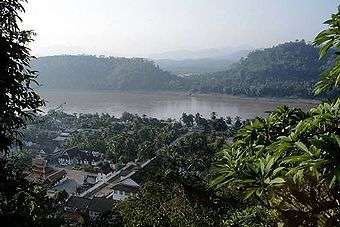
Area:
total: 236,800 km²
land: 230,800 km²
water: 6,000 km²
Area - comparative: slightly larger than Minnesota
slightly larger than half of Yukon
Land boundaries:
total: 5,083 km
border countries: Burma 235 km, Cambodia 541 km, the People's Republic of China 423 km, Thailand 1,754 km, Vietnam 2,130 km
Coastline: 0 km (landlocked)
Maritime claims: none (landlocked)
Elevation extremes:
lowest point: Mekong River 70 m
highest point: Phou Bia 2,817 m
Environmental concerns
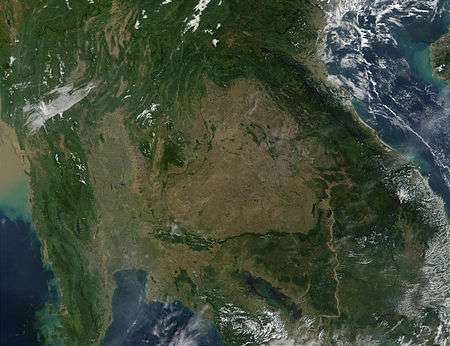
Natural hazards: floods, droughts, blight and earthquakes in the northern areas.
Air pollution agricultural burning ("slash and burn"), garbage burning
Environment - current issues: unexploded ordnance; deforestation; soil erosion; a majority of the population does not have access to potable water
Environment - international agreements:
party to: Biodiversity, Climate Change, Climate Change-Kyoto Ptorocol, Desertification, Endangered Species, Environmental Modification, Law of the Sea, Ozone Layer Protection
signed, but not ratified: none of the selected agreements
See also
References
"Laos." Encyclopedia Britannica Online. Encyclopedia Britannica, n.d. Web. 13 Nov. 2016.
Kittikhoun, Anoulak. "Small State, Big Revolution: Geography and the Revolution in Laos." Theory & Society 38.1 (2009): 25-55. Print.
Savada, Andrea Matles, et al. Laos : A Country Study. 3rd ed. ed. Washington, DC: Washington, DC : Federal Research Division, Library of Congress : For sale by the Supt. of Docs., U.S. G.P.O, 1995. Print.
"The World Factbook: LAOS." Central Intelligence Agency. Central Intelligence Agency, n.d. Web. 08 Nov. 2016.
 This article incorporates public domain material from the Library of Congress Country Studies website http://lcweb2.loc.gov/frd/cs/.
This article incorporates public domain material from the Library of Congress Country Studies website http://lcweb2.loc.gov/frd/cs/. This article incorporates public domain material from the CIA World Factbook website https://www.cia.gov/library/publications/the-world-factbook/index.html.
This article incorporates public domain material from the CIA World Factbook website https://www.cia.gov/library/publications/the-world-factbook/index.html.

